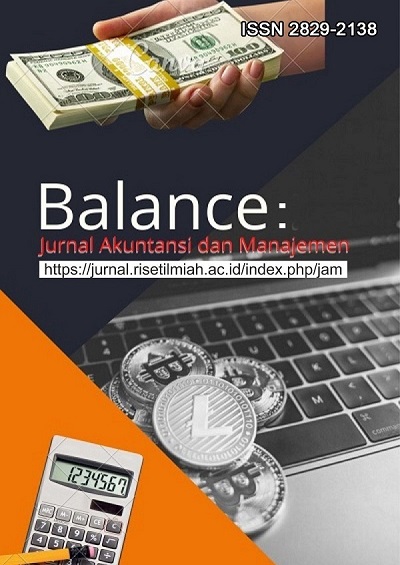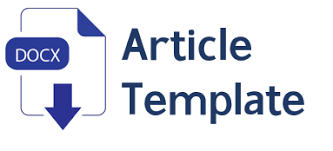Analisis Efektivitas Sistem Pengendalian Piutang Pada PT Samudera Puranabile Abadi Bitung
DOI:
https://doi.org/10.59086/jam.v4i2.1135Keywords:
Pengendalian Piutang, Risiko Piutang, COSO, Pengendalian InternalAbstract
This study aims to analyze the effectiveness of the receivables control system and identify ways to minimize the risk of uncollectible receivables at PT Samudera Puranabile Abadi Bitung. The underlying phenomenon of this study is the existence of bad receivables that can disrupt the company's liquidity. This study uses a qualitative descriptive methodology, with data collection techniques such as interviews, observations, and documentation. The data obtained was analyzed using the Miles and Huberman interactive analysis model, through three main stages: data reduction, data presentation, and conclusion drawing and verification. This analysis process makes it possible to find patterns and relationships between different parts of the internal control system based on field findings. The analysis is based on COSO's internal control theory, which includes five main components, namely the control environment, risk assessment, control activities, information and communication, and monitoring. The findings of the study show that the company's receivables control system has functioned effectively across all components of the COSO, contributing to smooth cash flow and credit risk management. The implications of this study highlight the importance of integrating credit policy with an internal supervisory system. The uniqueness of this research lies in the application of the COSO model in the context of the shipbuilding industry, which is still underexplored in Indonesia.
Downloads
References
Arianto, A. T. S. (2021). Analisis Pengendalian Piutang Untuk Meminimalisir Resiko Piutang Tak Tertagih Pada Koperasi Serba Usaha Artha Guna Kwaron. JFAS : Journal of Finance and Accounting Studies. https://doi.org/10.33752/jfas.v3i1.259
Aytac, A. G. A., & Cabuk, A. (2020). ASSESSMENT OF THE EFFECTIVENESS OF INTERNAL CONTROL SYSTEM AND A CASE STUDY. Journal of Accounting and Taxation Studies, 13(2), 353–376. http://www.conservation.gen.nz/documents/science-and-technical/casn151.pdf
Ayu, R. (2023). Analisis Sistem Pengendalian Piutang Terhadap Piutang Tak Tertagih pada PT. Abadi Sakti Mitra Mandiri. Jurnal EMT KITA, 7(4), 911–924. https://doi.org/10.35870/emt.v7i4.1516
Fatimah, Harun, H., & Musdalifah. (2023). Analisis sistem pengendalian intern dalam memperkecil resiko piutang tak tertagih pada pt. nusa surya ciptadana cabang mamuju. Kia10, 1–13.
Fitria, F., & Fahmi, M. (2020). EFEKTIVITAS SISTEM PENGENDALIAN INTERNAL MENGGUNAKAN PENDEKATAN COMMITTEE OF SPONSORING ORGANIZATION OF TREADWAY COMMISION (COSO) DI PT. INDONESIA ASAHAN ALUMINIUM (PERSERO). LITERASI JURNAL EKONOMI DAN BISNIS, 2(1), 27–47.
Gazali, A., Karamoy, H., & Gamaliel, H. (2020). Pengaruh Leverage, Kepemilikan Institusional dan Arus Kas Operasi Terhadap Penghindaran Pajak Pada Perusahaan Tambang yang Terdaftar di Bursa Efek Indonesia Periode 2014-2019. Jurnal Riset Akuntansi Dan Auditing “GOODWILL,” 11(2), 83–96.
Hafid, Abdullah; Siregar, Baldric; Biyanto, F. (2025). Pengaruh Pengendalian Internal terhadap Kualitas Pelaporan Keuangan dengan Sistem Informasi Akuntansi sebagai Variabel Moderasi pada Perusahaan Tekstil Skala Menengah di Daerah Istimewa Yogyakarta dan Sekitarnya. 4(3), 1586–1594.
Hanifa, P., & Megawati, L. (2023). Pengaruh Perputaran Kas dan Perputaran Piutang Terhadap Profitabilitas. Jurnal Ilmu Komputer Dan Bisnis, 14(2a), 21–36. https://doi.org/10.47927/jikb.v14i2a.538
Hanun, R. J., & Widiawati, HS; Kurniawan, A. (2025). Peran Standar Akuntansi, Sistem Informasi, Pengendalian Internal, dan Kompetensi SDM dalam Kualitas Laporan Keuangan Pemerintah Daerah. Balance: Jurnal Akuntansi Dan Manajemen, 4(2), 53–60.
Harahap, R. D., & Syafina, L. (2025). Mengurangi Risiko Piutang Tak Tertagih Pada Toko Material Bangunan ( Ud ) Di Kecamatan Ketambe. 14(02), 579–593.
Jawa, Y. M., Pratiwi, Y., & Lestari, S. D. D. (2024). Analisis Manajemen Piutang dalam Meningkatkan Laba pada Koperasi Wanita Bina Citra Wanita Gresik Periode Tahun 2020-2023. EKOMA : Jurnal Ekonomi, Manajemen, Akuntansi, 3(6), 857–866. https://doi.org/10.56799/ekoma.v3i6.4550
Karim, A. (2024). Pengaruh Perputaran Piutang Terhadap Tingkat Profitabilitas Pada PT Pertamina ( Persero ). 7(1), 770–780.
Komalasari, W., & Ardiansyah, A. (2025). Analisis Risiko Gagal Bayar Piutang Unit Simpan Pinjam Koppeg RSU R. Syamsudin, SH. Jurnal Ekualisasi, 6(2), 47–61. https://doi.org/10.60023/p8ae8t34
Kusumawati, R. A., & Yustika Rizkiana Bahari. (2023). Efektivitas Sistem Pengendalian Piutang Usaha Pada UD Cahaya Masohi di Masa Covid-19. Jurnal Aplikasi Bisnis, 20(1), 403–422. https://doi.org/10.20885/jabis.vol20.iss1.art9
Nurbaeti, E., Hambani, S., Aziz, A. J., & Anwar, S. (2023). Sistem Informasi Akuntansi Dan Pengendalian Internal: Kajian Pada Efektivitas Pengelolaan Piutang. Jurnal Akunida, 9(2), 128–136.
Nursafaat, F., Saputra, A. M. H., & Waldiana, W. (2022). Pengaruh Penjualan Kredit Dan Perputaran Piutang Terhadap Laba Pada Cv. Geka Gemilang Ciamis. Transekonomika: Akuntansi, Bisnis Dan Keuangan, 2(4), 23–30. https://doi.org/10.55047/transekonomika.v2i4.138
Pur Dwiastuti, M. M., Sukmarani, W., Untara, U., & Chandra, Y. I. (2023). Analisis Penerapan Sistem Pengendalian Internal Pada PT. SISFOMEDIKA Yogyakarta. Jurnal Esensi Infokom : Jurnal Esensi Sistem Informasi Dan Sistem Komputer, 7(2), 86–92. https://doi.org/10.55886/infokom.v7i2.764
Qomaruddin, Q., & Sa’diyah, H. (2024). Kajian teoritis tentang teknik analisis data dalam penelitian kualitatif: Perspektif Spradley, Miles dan Huberman. Journal of Management, Accounting, and Administration, 1(2), 77–84.
Rojak, F. M., Fariz, L. A., & Husen, D. S. (2024). Prinsip Pengelolaan Piutang: Strategi Efektif untuk Meningkatkan Arus Kas Perusahaan. EKALAYA : Jurnal Ekonomi Akuntansi, 2(4), 44–51. https://doi.org/10.59966/ekalaya.v2i4.1443
Rumamby, W. P., Kalangi, L., & Suwetja, I. G. (2021). Evaluasi Implementasi Pengendalian Internal Berbasis Coso Pada Pt. Moy Veronika Evaluation of Internal Control Implementation Based on Coso in Pt. Moy Veronika. 261 Jurnal EMBA, 9(2), 261–268.
Safrizal, S., & Sumiyati, S. (2024). Analysis of Internal Control of Bad Receivables. Talent: Journal of Economics and Business. https://doi.org/10.59422/jeb.v2i01.293
Saputra, M. A. (2023). Sistem Pengendalian Internal Berdasarkan COSO Framework Pada Perusahaan Konstruks. Jurnal Riset Akuntansi Politala, 6(1), 197–210.
Stender, S. (2023). Improvement of accounting and tax accounting of receivables. Scientific Bulletin of Mukachevo State University. Series Economics, 10(2), 42–53. https://doi.org/10.52566/msu-econ2.2023.42
Sugiyono. (2017). Metode penelitian kuantitatif, kualitatif dan R&D. Alfabeta.
Werita, D., & Reski Nofrialdi. (2021). Analisis Efektivitas Pengelolaan Dan Sistem Pengendalian Piutang Pada PT. Dagna Medika. Jurnal Akademi Akuntansi Indonesia Padang, 1(1), 13–21. https://doi.org/10.31933/prn9sa51
Downloads
Published
How to Cite
Issue
Section
License
Copyright (c) 2025 Ahmad Gazali, Pricilia Joice Pesak, Alfred Salindeho

This work is licensed under a Creative Commons Attribution 4.0 International License.
This is an open-access journal. All works are published under the Creative Commons license CC-BY which means that all content is freely available at no charge to the user or his/her Institution. Users are allowed to read, download, copy, write, improve, and create derivative creation even for other lawful purposes, this license permits anyone to, as long as they cite and license the derivative creation under similar terms

This work is licensed under a Creative Commons Attribution 4.0 International License.
Most read articles by the same author(s)
- Alfred Salindeho, Ahmad Gazali, Pricilia Joice Pesak, Perhitungan Dan Dampak Pph Pasal 21 Di PDAM Duasudara Kota Bitung Berdasarkan Tarif Efektif Rata-Rata , Balance : Jurnal Akuntansi dan Manajemen: Vol. 4 No. 1 (2025): April 2025
- Pricilia Joice Pesak, Lenny Leorina Evinita, Michael Miran, Ahmad Gazali , Alfred Salindeho , Evaluasi Coretax Berbasis Technology Acceptance Model: Perspektif Aparat Pajak , Balance : Jurnal Akuntansi dan Manajemen: Vol. 4 No. 3 (2025): Desember 2025


















